
Travelogue
Photos
Today
Banamargy Friary
Kinbane Castle
Carrick-a-Rede bridge
Bushmill's Distillery
Dunluce Castle
Giants Causeway
Dunseverick Castle
Torr Head
Cushenden Ringfort
Cushenden Castle
Glenarm Castle
Travelogue, Day 24
I cannot gush enough about the fabulousness of the Barbican Gatelodge from the National Trust. This is such a GREAT place! Our own little tower house, a tiny castle all our own, that is impeccably restored and designed for visitors. A floor for the kitchen (all packed into a teeny space, but with all the "mod-cons", as the UK real estate mags note), the next floor a bed room and, slightly offset, a bathroom with the biggest bathtub I have ever seen, and then a sitting area on the roof that looks over the grounds of the castle. A spiral staircase links all the floors, which have heavy oak and iron doors. Even the bed is comfortable, and the bookshelves are stocked with interesting stuff.
Can it GET better than this? We're only staying three days, but I wish it were at least a week. Or more.
We do have an infestation of pill bugs, though. The caretaker apologized profusely about it, but "it happens in spring", she said wryly There's really nothing they can do -- the stone buildings stay warm enough in the winter to harbor the bugs, so they hatch up in the spring and are everywhere for a few weeks. They're harmless, of course. It does make getting out of bed in the night a bit chary, though -- you may step on the creatures if you're not careful, which is kind of gross, but they tend to stay on the floor and underneath things, so it's not a big deal.
No big deal, unless you have to pee in the middle of the night.
You can see this coming, can't you? Oh, yeah, that's me. Pee in the middle of night. It's like I have a switch that goes off every few hours. I really don't understand the sort of person who can wake up, realize that they have to pee, and then go back to sleep. I'm married to one, and I still don't get it. So here's me, waking up at 2am and venturing across the room and down the stairs into the bathroom.
I'm a bit bug phobic, so if these little beasties ventured anywhere other than the floor, I'd probably have freaked out royally (and loudly, the husband just commented with a snort). As it stands, though, I just learned to turn on the lights and walk gingerly. I'm sure I stepped on a few and I’m blocking the memories.
Mark -- being the morning person -- whipped up breakfast of slabs of Irish bacon, scrambled eggs, and toast, and we had a leisurely morning. There is no shower here, but the bathtub, as noted, is HUGE. It has got to be seven feet long -- I have to be careful or I'd submerge myself, and I have started having fantasies of lovely wine, lovely candles, and a shared bubble bath…. Hm. Must talk to Mark about this.
Revving for Takeoff
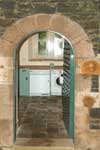 He did laundry this morning, too, while letting me sleep (Have I mentioned that he's the best husband ever?). But he couldn't resist waking me up to see the washer r on the first floor (across the entry in the "other" tower). He was fascinated by the teeny little washer and equally small dryer. The dryer was marked with RPM, which had us laughing a bit, and had settings that would be entirely unfamiliar to a US traveler."Cupboard Dry", "Hang dry." huh? Wha?
He did laundry this morning, too, while letting me sleep (Have I mentioned that he's the best husband ever?). But he couldn't resist waking me up to see the washer r on the first floor (across the entry in the "other" tower). He was fascinated by the teeny little washer and equally small dryer. The dryer was marked with RPM, which had us laughing a bit, and had settings that would be entirely unfamiliar to a US traveler."Cupboard Dry", "Hang dry." huh? Wha?
He did two loads, and we fiddled with the settings. The load came out almost dry from the washer, which reinforced the idea that most people don't dry clothes in a "dryer", but rather hang them in a cupboard or outside. Seriously, imagine two American tourists so fascinated by an Irish washer (I have no idea who actually made the thing, Bosch, I think) that we actually watched the load. It revved up like an SST on the runway, and disgorged our clothes clumped up, wrinkled, but almost dry. Opening the cabinet next to the washer, we hung them on the provided hangers. Voila!
Count us as weird techno-geeks, though. He took pictures of the washer. I laughed.
We drove up the Antrim coast today, to see the plethora of sites clustered in this northeast corner of Ireland. It started out so foggy and drizzly today that we despaired of seeing anything. Fog was creeping down to the point that we were driving through it most of the time and everything was fading into the same pale, fuzzy gray. I shouldn't complain -- the weather for our whole trip has been fabulous -- sure, a bit of rain, but most days are gloriously warm with blue skies and sunshine. Once again, I have managed to get sunburned not once, but twice, while traveling in a country that is specifically known for having rain every day in the spring. Hah!
But today, the sea is gray and the clouds almost merge with the waves as we drove up the coast road. Heading inland a bit, we stopped first at Banamargy Friary near Ballycastle. We had to drive up over the mountain pass on teeny, narrow roads (and stopped for a stupendous view near the peak, where we met up with people who had BIKED up!) and then swooped down the back side of the mountain and voila! The weather cleared. Still gray, but things were brightening up.
String of Castles
Banamargy is a small friary that has a commanding hill view, but wasn't particularly notable otherwise. Most of the buildings are completely gone, and it's hard to pick out any of the actual structure of the church and cloister buildings here. But it was interesting to look at the gravestones in the churchyard and inside the roofless stone church. Many are WWI headstones, with carved symbols for the navy, for masons, and quite a few that we didn't recognize. And, in the main churchyard, is a strange holed cross. Faces and interlocking designed carved into the church walls are very weathered, and it took us quite a bit of effort to trace out the plan of this little church, even after we found the placard with the plans. I love puzzling out this sort of thing.
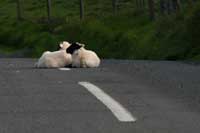 We continued up the coast, which has some of the most beautiful scenery that we've seen so far in Ireland. The coasts are rocky and steep, the fields are such a lush green that don't seem real, and every turn opens up to new vistas over the sea that are better than the last. Sheep fields run right down to the rocky shoreline. While most fields have either stone walls or fencing of some sort, sheep are not the smartest of creatures and we cam up over the to of a hill to find two lambs laying in the middle of the road on the sun-warmed asphalt. Mama was quite calmly sleeping on the grassy curb, but the two lambs were oblivious to cars. The road isn't wide enough to drive around them (despite the fact that the lovely asphalt road has a neat white centerline painted on it) and we crept up quietly until we could gently urge them to get up and get out of the way. After stopping and taking pictures of course, and hoping they WOULDN"T move until we had done that!
We continued up the coast, which has some of the most beautiful scenery that we've seen so far in Ireland. The coasts are rocky and steep, the fields are such a lush green that don't seem real, and every turn opens up to new vistas over the sea that are better than the last. Sheep fields run right down to the rocky shoreline. While most fields have either stone walls or fencing of some sort, sheep are not the smartest of creatures and we cam up over the to of a hill to find two lambs laying in the middle of the road on the sun-warmed asphalt. Mama was quite calmly sleeping on the grassy curb, but the two lambs were oblivious to cars. The road isn't wide enough to drive around them (despite the fact that the lovely asphalt road has a neat white centerline painted on it) and we crept up quietly until we could gently urge them to get up and get out of the way. After stopping and taking pictures of course, and hoping they WOULDN"T move until we had done that!
Ruins of castles and churches pretty much line the coast up here, and we stopped at them in order as we came upon them. Kinbane was the first castle we saw signposted. The signpost was a bit of a surprise; we've gotten so used to things not being labeled at all, or having a teensy little sign tacked to the corner of a building. Northern Ireland, though, seems to follow the same plan as Scotland and most of England do - everything that might possibly be interesting has a sign associated with it. It was almost a relief, by this point. They actually do signpost everything with brown signs for Heritage Sites , and they tend to have actual road signs scattered about.
Danger Girl, Part III
The car park for Kinbane was empty, and as soon as we approached the path, we understood why: a tiny sign noted that the path was closed because of some recent landslides. It was too dangerous to allow visitors to climb down. It was impossible to see the castle from the road, though; it's behind the rocky outcropping and down on a tiny rocky outcropping.
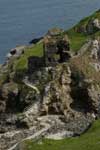 So, despite my misgivings, Mark hopped the fence and sidled off down the narrow path to see if he could get a few pictures anyway. He reappeared about ten minutes later to report that yes, most of the cliff face (and hence the path) had fallen into the sea and it had been a pretty hair climb to get around far enough to get some pictures of the tiny tower house of Kinbane. He hadn't ventured much further around, since the path seemed even less stable, so he just snapped pictures and climbed back up. He popped back over the fence about the time I had decided that he'd pitched headfirst into the sea and was trying to figure out who to call to report that a stupid tourist had ignored the signs and managed to kill himself!
So, despite my misgivings, Mark hopped the fence and sidled off down the narrow path to see if he could get a few pictures anyway. He reappeared about ten minutes later to report that yes, most of the cliff face (and hence the path) had fallen into the sea and it had been a pretty hair climb to get around far enough to get some pictures of the tiny tower house of Kinbane. He hadn't ventured much further around, since the path seemed even less stable, so he just snapped pictures and climbed back up. He popped back over the fence about the time I had decided that he'd pitched headfirst into the sea and was trying to figure out who to call to report that a stupid tourist had ignored the signs and managed to kill himself!
lf you have any fear of heights whatsoever, avoid the Carrick-a-rede rope bridge (which really isn't rope anymore, but metal cables and fencing and such). A small bridge that let the mainlanders get across to the tiny island fishery is actually very stable, and it's fun to bounce your way across to the little island. I wasn't as sure about it as Mark was, especially after walking along the coastal path (about a foot wide). Everyone tries to jounce and bounce the bridge for everyone else - if you get more than two people it wobbles alarmingly with each step. The fishery isn't working anymore, but the little island is very quiet and rather nice to just sit on and enjoy the weather.For some reason, the walk back over the bridge to the mainland isn't a exciting as going out. Go figure.
A wee Dram
Bushmills is about the best-known brand of Irish Whiskey (note the 'e') and the old distillery is a very populate tourist spot. The original buildings and storage are here, and the old buildings have been made into part of the tour. The whiskey isn't actually made here any more -- the facilities have moved a bit upriver to a much larger, more modern distillery.
The tour is interesting (although to be honest, if you've toured on distillery, they really are all the same - -just the buildings and the shape of the stills changes) and I love seeing the old mill buildings and machinery. Mark loves the old firehouse stuff - with the grains being used and the dust that produces, fires were a common danger. There are pictures all over of the early day of the distillery, with men rolling barrels into skiffs and into horse-drawn wagons, and carrying sacks of grain and bottles around.
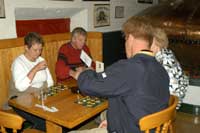 One note - at the end of the tour, when they are showing you the stored casks and talking about how long they are warehoused to age…push yourself to the front of the group and get your hand up as soon the tour guide asks for volunteers! There is a guided tasting back in the restaurant that is really worth it - taste Scotch, Bourbon, and a few different brands of Irish whiskey. They pick four people (usually two women and two men) for the tasting. Everyone else gets a single dram at the conclusion of the tour, of course, but if you want to taste anything else you have to buy it. The cafe here is very good, too.
One note - at the end of the tour, when they are showing you the stored casks and talking about how long they are warehoused to age…push yourself to the front of the group and get your hand up as soon the tour guide asks for volunteers! There is a guided tasting back in the restaurant that is really worth it - taste Scotch, Bourbon, and a few different brands of Irish whiskey. They pick four people (usually two women and two men) for the tasting. Everyone else gets a single dram at the conclusion of the tour, of course, but if you want to taste anything else you have to buy it. The cafe here is very good, too.
Clifftop Castles
We arrived at Dunluce about the same time a television crew did, taping someone that we did not recognize could do a television documentary. We were advised to look about quietly and not disturb them. I, of course, pretty much followed them around and listened to the commentary on the castle. There is a gatehouse and bridge that spans a deep chasm before getting into the castle itself. Dunluce was inhabited for centuries, and each century's addition to the castle are obvious.
That's true of most castles--each successive inhabitant changes the structure, adding rooms, adding floors, making windows larger, adding more towers or outbuildings. Sometimes things look like patchwork quilts. One of the interesting details here is the weird floor treatment in what was probably the kitchens - the floor is cobbled in thick stripes. No one was really able to explain why. Of course, one of the best stories about the castle is that part of the great hall fell into the sea, apparently with people sitting to dinner!
There are dozens of things to see here along the coast, and one of the huge draws is the bizarre stone beach of The Giant's Causeway. It really is a remarkable place - thousands of hexagonal stone columns that march up out of the sea and up the cliff sides. It's as if the landscape is made of bundled sticks, or one of those desktop-game pin tables, When ey9ou press on one side and the pins poke up on the other to make shapes.
Scotland has a similar coastline just across the water, which is why the legend is that this is the collapsed bridge of a giant who would step across from island to island. It's fantastical and otherworldly, to say the least.
Dunseverick Castle is just a bit further down the coast (we just followed the lovely brown and white tourist signs and voila! Arrived there in a trice!). Compared to Dunluce, there is almost nothing here -- just the cragged remains of a tower on the cliff side. There was no obvious way to get out to the ruins, so we snapped a few pictures from the path and didn't venture too far. It doesn't look very stable, to be honest.
We didn't actually see Cushenden Castle, to be honest; we saw first the gorgeous horse running in the pasture and stopped to watch for a moment. Then we realized that there was the stub of a ruined tower in the field as well and spent a half-hour tying to get a well-lit picture, unblurred, of the horse running in front of the castle. We don't often make the attempt to be too terribly arty in our photography, but it was hard to pass up.
RGB Color Codes
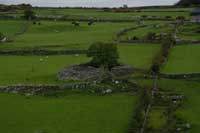 It's an absolutely unbelievable shade of green here today. It doesn't look real -- it's brilliant, vivid technicolor green in all directions. All this talk of Ireland as the "Emerald Isle" sounds like marketing, but I have never seen a place that is a deeper, lusher green. In truth, it is all shades of green - emerald, chartreuse, fern, hunter green, jade, kelly, lime, moss, olive, pine, sea green, viridian, melon. The overriding sense is of a place that is lush and fertile and burgeoning with life. I'm sure that some of the pictures look as if I have color-enhanced them, and I assure you that I have not!
It's an absolutely unbelievable shade of green here today. It doesn't look real -- it's brilliant, vivid technicolor green in all directions. All this talk of Ireland as the "Emerald Isle" sounds like marketing, but I have never seen a place that is a deeper, lusher green. In truth, it is all shades of green - emerald, chartreuse, fern, hunter green, jade, kelly, lime, moss, olive, pine, sea green, viridian, melon. The overriding sense is of a place that is lush and fertile and burgeoning with life. I'm sure that some of the pictures look as if I have color-enhanced them, and I assure you that I have not!
We saw a ringfort today, in the middle of one of the walled fields. These neolithic circles have thick stone walls and served as homes or defense or both. Over 45,000 sites have been identified as ringforts throughout Ireland, as many as 60,000 may exist, based on aerial photography and other archeological hints. We don't specifically look for these, but we see them all over the place. Sometimes the walls are just a faint ring on mound of earth, others are still eight or ten feet tall and and look almost new. Most have been scavenged for building stone; I would imagine that the stone walls in the fields around them are probably build from stone taken from the ring forts. That's what happens to a lot of these old stone buildings: stone is reusable. When the current building is no longer in use or not longer safe, the stones are taken and used to build something else. That's true the world over - the facing stones of the Egyptian pyramids were taken and used for buildings in Cairo; the oak floors of an 18th century mill turn up in the planking on a modern warehouse, just like the building materials from a modern house are scavenged and used in new construction.
It was a very tiring day, all told. Lots of walking up and down hills and clambering over rocks. We decided to call it a day and go relax with some wine in our castle retreat. We're not supposed to bother the actual castle near the Barbican (Glenarm Castle), but we did walk around the ground a bit and take some pictures of the surrounding wall and of the castle itself (a baronial mansion, actually, but quite imposing). We must stay on the white gravel paths and not actually approach the house, since only the gatelodge is under the care of the National Trust.
We started a fire, curled up with some good books, and relaxed. Aaah.